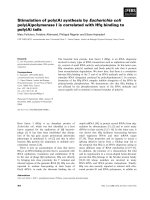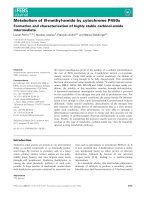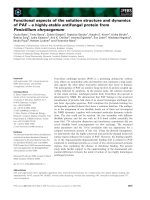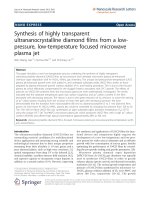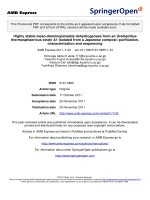Fructooligosaccharides synthesis by highly stable immobilized -fructofuranosidase from Aspergillus aculeatus
Bạn đang xem bản rút gọn của tài liệu. Xem và tải ngay bản đầy đủ của tài liệu tại đây (756.47 KB, 5 trang )
Carbohydrate Polymers 103 (2014) 193–197
Contents lists available at ScienceDirect
Carbohydrate Polymers
journal homepage: www.elsevier.com/locate/carbpol
Fructooligosaccharides synthesis by highly stable immobilized
-fructofuranosidase from Aspergillus aculeatus
André S.G. Lorenzoni, Luiza F. Aydos, Manuela P. Klein, Rafael C. Rodrigues,
Plinho F. Hertz ∗
Biotechnology, Bioprocess and Biocatalysis Group, Institute of Food Science and Technology, Federal University of Rio Grande do Sul, Av. Bento Gonc¸alves,
9500, P.O. Box 15090, ZC 91501-970, Porto Alegre, RS, Brazil
a r t i c l e
i n f o
Article history:
Received 11 October 2013
Received in revised form 2 December 2013
Accepted 14 December 2013
Available online 21 December 2013
Keywords:
Enzyme
Immobilization
Fructooligosaccharides
Viscozyme L
Chitosan
a b s t r a c t
The enzymatic synthesis of fructooligosaccharides (FOS) was carried out using a partially purified
-fructofuranosidase from the commercial enzyme preparation Viscozyme L. Partial purification of
-fructofuranosidase from Viscozyme L was done by batch adsorption using ion-exchange resin DEAESepharose, showing a 6-fold increase in specific activity. The biocatalyst was then covalently immobilized
on glutaraldehyde-activated chitosan particles. Thermal stability of the biocatalyst was evaluated at 50 ◦ C
and 60 ◦ C, being around 100 times higher at 60 ◦ C when compared to the free enzyme. The immobilized
biocatalyst was reused 50 times for FOS production (100 min per batch at 50 ◦ C and pH 5.5) without
significant loss of activity. The average yield (grams of FOS per grams of initial sucrose) was 55%. The
immobilization process combined with partial purification method resulted in a derivative with activity
of 1230 Ut /g, which is among the best for FOS production.
© 2013 Elsevier Ltd. All rights reserved.
1. Introduction
Fructooligosaccharides (FOS), also known as oligofructose, are
prebiotic food ingredients. This classification refers to its non
digestibility, fermentation by intestinal microflora and selective
stimulation of intestinal bacteria that contribute to a better health
and well-being (Roberfroid, 2007). They can be obtained by
inulin hydrolysis, using endoinulinase, or by synthesis, using fructofuranosidase (E.C.3.2.1.26, E.C.2.4.1.9). The FOS obtained from
sucrose (-d-fructofuranosyl(2→1)␣-d-glucopyranoside) has a
shorter chain than those from inulin, having more sweetening
power, and may be used as a sweetener by diabetics (Mabel,
Sangeetha, Platel, Srinivasan, & Prapulla, 2008).
Although the synthesis of FOS from sucrose is economical
because sucrose is cheaper than inulin, the use of enzymes as catalysts for large-scale industrial processes is costly and once they have
been made soluble, their recovery for reuse is not economically
practical. The immobilization of enzymes allows an easy reuse and
other advantages, for example, better stability, continuous operation and reducing overall costs (Liese & Hilterhaus, 2013; Sheldon
& Van Pelt, 2013).
∗ Corresponding author. Tel.: +55 51 3308 7094; fax: +55 51 3308 7048.
E-mail addresses: (R.C. Rodrigues),
(P.F. Hertz).
URL: (P.F. Hertz).
0144-8617/$ – see front matter © 2013 Elsevier Ltd. All rights reserved.
/>
Chitosan [(1→4)-2-amino-2-deoxy--d-glucan] has been used
as a carrier for enzyme immobilization since the 70s (Kasumi,
Tsuji, Hayashi, & Tsumura, 1977; Muzzarelli, Barontini, & Rocchetti,
1976). In recent studies, protocols for enzyme immobilization on
chitosan were developed, resulting in stable biocatalysts, for galactosidase (Klein et al., 2012), invertase (Valerio, Alves, Klein,
Rodrigues, & Hertz, 2013) and for chitinase (Seo, Jang, Park, &
Jung, 2012). Obtained from chitin [(1→4)-2-acetamido-2-deoxy-d-glucan], that is subjected to N-deacetylation followed by
purification procedures, the production of chitosan is an economically attractive use for crustacean shells (Krajewska, 2004).
The commercial enzyme preparation from Aspergillus aculeatus
(Pectinex Ultra SP-L) has been the aim of several studies for FOS
production in both free and immobilized form (Csanádi & Sisak,
2006; Ghazi et al., 2007; Tanriseven & Aslan, 2005). Recent study
has shown that Viscozyme L, other preparation from A. aculeatus
has even more -fructofuranosidase activity than Pectinex Ultra
SP-L (Vega-Paulino & Zúniga-Hansen, 2012). It is interesting to note
that both enzyme preparations have other key enzyme activities
apart from -fructofuranosidase. Pectinex Ultra SP-L is marketed
as polygalacturonase that hydrolyzes (1→4)-␣-d-galactosiduronic
linkages in pectate and other galacturonans, while Viscozyme L is
marketed as endo--glucanase that hydrolyzes (1→3)- or (1→4)linkages in -d-glucans.
Thus, the aim of this work is to prepare a highly stable
and active derivative of -fructofuranosidase from A. aculeatus
on chitosan particles for FOS synthesis. Firstly, the commercial
194
A.S.G. Lorenzoni et al. / Carbohydrate Polymers 103 (2014) 193–197
preparation Viscozyme L was partially purified to improve the fructofuranosidase activity, and the immobilized preparation was
evaluated for optimal pH and temperature, thermal stability, and
operational stability in FOS synthesis.
The immobilization yield (IY) and immobilization efficiency (EF)
were calculated by the same equations previously described by
Valerio et al. (2013).
2.6. Thermal stability
2. Materials and methods
2.1. Materials
Viscozyme L, a commercial enzyme preparation from A. aculeatus, produced by Novozymes, was kindly donated by LNF Latino
Americana. Centrifugal Filter Unit (30 kDa) was acquired from Millipore. DEAE-Sepharose fast flow® was acquired from Sigma-Aldrich.
Sucrose was acquired from Vetec Química Fina Ltda (Brazil). Enzymatic glucose (D-glucose) determination kit was from In Vitro
Diagnóstica Ltda (Brazil) and glutaraldehyde 25% was from Nuclear
(Brazil). The high liquid chromatography (HPLC) column used in
these tests was an Aminex® HPX-87C. All other chemicals were analytical or HPLC grade obtained from readily available commercial
sources.
2.2. Enzyme activity
The enzymatic activity assay was carried out using a substrate
solution of 100 g/L of sucrose in 50 mM sodium acetate buffer, pH
5.5 at 50 ◦ C. Samples were taken at regular intervals and the reaction was stopped by the addition of 0.1 M sodium carbonate buffer,
pH 10.0. Glucose release was measured with the enzymatic glucose determination kit. One unit of enzymatic activity measured
(U) was defined as the amount of enzyme that releases 1 mol of
glucose from sucrose per minute at test conditions. All the activities
of immobilized enzymes were carried out under agitation.
2.3. Enzyme purification
Viscozyme L was diluted in 20 mM sodium phosphate buffer (pH
5.8) to a final protein concentration of 20 mg/mL and then applied
to flasks containing DEAE-Sepharose previously equilibrated with
the same buffer. Desorption was carried out washing the resin with
the same buffer containing increasing concentrations of sodium
chloride. Most of enzyme was desorbed at 0.4 M of sodium chloride
solution. After desorption, protein solution was filtrated using a
centrifugal filter (30 kDa; 4000 × g; 40 min; 4 ◦ C) to concentrate the
-fructofuranosidase and to remove the salt.
2.4. Preparation and activation of chitosan particles
The chitosan particles were prepared using the protocol
described by Klein et al. (2012). Briefly, a chitosan solution was
added dropwise into an alkaline coagulation solution, and the
activation was performed by incubating the chitosan particles
obtained with a glutaraldehyde solution (4%, v/v) prepared in 0.1 M
phosphate-sodium buffer (pH 7.0), at room temperature for 3 h in
an orbital shaker at 120 rpm with 12 mm of orbital diameter. The
activated support was exhaustively washed with 50 mM sodium
acetate buffer (pH 5.5) to remove the excess glutaraldehyde.
2.5. Enzyme immobilization
Chitosan particles were incubated with partially purified
enzyme solution previously diluted in 50 mM of sodium acetate
buffer (pH 5.5), for 3 h at room temperature and under gentle shaking. The immobilized enzyme was washed with, buffer, NaCl (1.0 M)
and ethylene glycol (30%, v/v) to eliminate unbounded and ionic
and hydrophobic bounded enzymes.
Soluble and immobilized enzymes were incubated at 50 ◦ C and
60 ◦ C for up to 9 days. Samples were withdrawn at intervals, placed
in ice bath to stop thermal inactivation and enzyme activity was
then measured.
In general, thermal inactivation of enzymes can be described by
a first order reaction,
A
= exp(−kt)
A0
(1)
where A is the enzyme activity at time t, A0 the initial enzyme activity, t is the treatment time, and k is the constant inactivation rate at
the studied temperature. In this work, k was determined by fitting
the first order model to the data of the residual enzyme activity plot
(A/A0 ) versus time (min) using nonlinear regression (Statistica 7.0,
StatSoft, Inc., Tulsa, OK, USA).
The enzyme half-life (t1/2 ) represents the time required for the
enzyme to decay to 50% of its initial value of activity and was calculated from the values of k, following this equation:
t1/2 =
ln(2)
k
(2)
2.7. Determination of optimal pH and temperature
The optimal pH and temperature were assayed for both partially
purified (soluble) and immobilized enzymes. The optimal pH tests
ranged from 3 to 8, maintaining the temperature constant at 50 ◦ C
and the optimal temperature was assayed from 42 ◦ C to 80 ◦ C maintaining pH at 5.5. The buffers (50 mM) used were glycine–HCl pH
3.0, sodium acetate pH 4.0, 5.0 and 5.5, and sodium phosphate pH
6.0, 6.5, 7.0, 7.5 and 8.0.
2.8. Fructooligosaccharides production
The FOS production was carried out at 50 ◦ C using a solution
of sucrose 600 g/L in 50 mM sodium acetate buffer pH 5.5. Fifty
chitosan particles (22 U) were incubated in 2 mL of sucrose solution
for 160 min. Samples were taken at 15 min intervals, for kinetic
evaluation.
Reactions were carried out for 100 min at the same conditions,
for operational stability evaluation. The particles were washed
between batches with 50 mM sodium acetate buffer pH 5.5 to
remove any trace of product. Samples were taken after each batch.
The samples were assayed for reducing sugars by the DNS
method (Miller, 1959) and enzymatically for glucose. Fructose
(d-fructose) was calculated as the difference between the concentrations of reducing sugars and glucose, FOS molar concentration
was calculated as difference between the molar concentrations of
glucose and fructose.
The samples were also analyzed by an HPLC system
(Shimadzu, Tokyo, Japan) equipped with refractor index
and Aminex HPX-87C (300 mm × 7.8 mm) column. Ultrapure water was used as eluting solvent at a flow rate of
0.6 mL min−1 , at 85 ◦ C. The concentration of saccharides
[sucrose, glucose, fructose, kestose (-d-fructofuranosyl(2→1)d-fructofuranosyl(2→1)␣-d-glucopyranoside)
and
nystose
(-d-fructofuranosyl(2→1)-d-fructofuranosyl(2→1)-dwas
determined
fructofuranosyl(2→1)␣-d-glucopyranoside)
by interpolation using external standards. HPLC analysis was
carried out to confirm the assessment method and for direct
A.S.G. Lorenzoni et al. / Carbohydrate Polymers 103 (2014) 193–197
195
Fig. 2. Relative activity of the free enzyme at 50 ◦ C ( ), immobilized enzyme at 50 ◦ C
( ), free enzyme at 60 ◦ C ( ) and immobilized enzyme at 60 ◦ C ( ).
Fig. 1. Activity ( ) measured on the immobilized biocatalyst for each amount of
protein tested on immobilization.
measurement of transfructosylation activity of the immobilized
biocatalyst. Transfructosylation activity (Ut ) was defined as the
amount of enzyme that produces 1 mol of kestose or nystose
from sucrose per minute.
3. Results and discussion
3.1. Enzyme partial purification
Crude Viscozyme L has a -fructofuranosidase specific activity
of 4.2 U/mg and volumetric activity of 500 U/mL, at 50 ◦ C and pH
5.5. The purification process resulted in an enzyme solution with
a specific activity of 25.0 U/mg resulting in a purification fold of
6.0 with an activity recovery of 60%. After centrifugal filtration, the
enzyme was concentrated to over 330 U/mL.
This purification is only partial, and can be improved as shown
by Ghazi et al. (2007), that purified a -fructofuranosidase from
A. aculeatus (Pectinex Ultra SP-L) and obtained a purification fold
of 107, obtaining a specific activity of 2635 U/mg, which is 105
times higher than the activity obtained in our work. On the other
hand, the activity recovery was only 36.8% after four purification
steps, which is smaller than 60% obtained in our work by one-step
purification. For the purification of Pectinex Ultra SP-L, a two step
process resulted in a purification fold of 7, recovering 22.3% of initial activity (Nemukula, Mutanda, Wilhelmi, & Whiteley, 2009). The
increase in enzyme purity can improve the immobilization conditions. However, enzyme isolation and purification can be expensive
and time consuming (de Carvalho, 2011), and the enzyme immobilization should be a relatively simple operation not requiring a
highly pure enzyme preparation that not always is commercially
available (Sheldon & Van Pelt, 2013).
3.2. Enzyme immobilization
The results of the different enzyme load applied to the support
are shown in Fig. 1. The best biocatalyst activity was obtained with
an amount of 120 mg of enzyme per gram of dry support. This
amount resulted in an immobilization yield of 90% and immobilization efficiency of 33%. The biocatalyst obtained has shown a
hydrolytic activity of 880 U per gram of dry support, equivalent to
0.44 U per chitosan particle.
As reported for other authors, the low immobilization efficiency
could be due to linkages with groups related to active site and those
responsible for maintaining the tertiary structure of the enzyme
(Tanriseven & Aslan, 2005). One possible solution, is the immobilization in the presence of substrate that can protect the active site
of the enzyme, improving efficiency (Cadena et al., 2010). In this
work, the presence of sucrose at 100 g/L and 600 g/L in the immobilization solution did not improve the immobilization efficiency,
as also reported by Valerio et al. (2013) for the -fructofuranosidase
from S. saccharomyces. Moreover, other reports showed similar
behavior for different enzymes (Csanádi & Sisak, 2006; Ghazi et al.,
ˇ
2005; Platková, Polakoviˇc, Stefuca,
Vandáková, & Antoˇsová, 2006;
Tanriseven & Aslan, 2005).
3.3. Thermal stability
The kinetic inactivation for both free and immobilized fructofuranosidase is shown in the Fig. 2 where the symbols refer to
the average experimental values, while lines correspond to fitting
Eq. (1) for the experimental data. The inactivation rate constant (k)
and the half-life (t1/2 ) for the free enzyme at 50 ◦ C and 60 ◦ C were
given in Table 1 with the determination coefficient r2 .
It was not possible to quantify the half-life of the immobilized
enzymes, because after 200 h the prepared biocatalyst presented
83% of its initial activity at 50 ◦ C, and 50% at 60 ◦ C, as depicted in
the Fig. 2. According to Gardossi et al. (2010) the experiment must
be carried out until 10% of residual activity to allow clear distinction
of kinetic inactivation model and proper half-life determination.
Due to the high thermal stability, 10% of residual activity would
be reached only after longer times. Fig. 2 clearly shows that the
immobilized enzyme is much more stable than the free enzyme at
both temperatures, proving that the immobilization onto chitosan
particles has a positive effect in the thermal stability of the enzyme.
An increase in the number of enzyme-supports bonds was suggested as the most likely explanation for the stabilization achieved
in the immobilized enzymes (Pedroche et al., 2007). However,
when using supports at non-alkaline pH values, the immobilization occurs only via the amino terminal group (Mateo et al., 2005).
Since in this work the enzyme is a dimeric glycoprotein (Ghazi et al.,
2007), such high stability could be due to chitosan attachment of
amino terminal group of both monomers of the enzyme, and then
stabilizing the enzyme quaternary structure.
This high thermal stability provides several advantages for the
biocatalyst, such as: the sucrose is easier solubilized at higher
Table 1
Kinetic parameters of thermal inactivation of free -fructofuranosidase at 50 and
60 ◦ C.
Biocatalyst
k (min−1 )
t1/2 (h)
r2
Free -fructofuranosidase at 50 ◦ C
Free -fructofuranosidase at 60 ◦ C
0.0169
0.2221
41.01
3.12
0.98
0.9627
196
A.S.G. Lorenzoni et al. / Carbohydrate Polymers 103 (2014) 193–197
Fig. 3. Effect of pH on the free ( ) and immobilized ( ) enzyme at 50 ◦ C.
temperatures (Young & Jones, 1949); microbial growth of
pathogenic microorganisms such as Staphylococcus aureus
(Schmitt, Schuler-Schmid, & Schmidt-Lorenz, 1990), Escherichia coli
and Salmonella enterica (Bronikowski, Bennett, & Lenski, 2001)
is avoided at 50 ◦ C; in addition, thermal stability of enzymes can
limit the long term application of the biocatalyst in the process
(Liese & Hilterhaus, 2013).
3.4. Determination of optimal pH and temperature
The results of optimal pH and temperature are shown in
Figs. 3 and 4, respectively. It was not observed changes in the
optimum pH comparing immobilized and free enzyme. However,
the immobilized enzyme is slightly more active at lower pH values (pH 3.0). Sometimes the support may be an ionic exchanger,
and may behave as a buffer, generating a pH inside the biocatalyst bead that may greatly differ from the pH value in the reaction
medium (Rodrigues, Ortiz, Berenguer-Murcia, Torres, & FernándezLafuente, 2013). However, this explanation could be discarded
since chitosan is a polyaminosaccharide without ionic strength and
the enzyme molecules probably get immobilized mostly in their
outer surfaces (Klein et al., 2012). This wider pH range may be
probably due to the stabilization of enzyme 3D structure by the
attachment on the support.
Fig. 4. Effect of the temperature on free ( ) and immobilized ( ) enzyme at pH 5.5.
Fig. 5. Kinetic evaluation of carbohydrates: nystose (᭹), kestose ( ), sucrose ( ),
glucose ( ), fructose ( ), total FOS ( ), during reaction with a new biocatalyst.
The optimum temperature for free enzyme was between 58 ◦ C
and 66 ◦ C, presenting 100% of relative activity on both temperatures. Nemukula et al. (2009) reported an optimal temperature of
60 ◦ C in a reaction of 40 minutes; on the other hand, Tanriseven
and Aslan (2005), reported an optimal temperature of 65 ◦ C in a
1 min reaction. These differences of optimal temperatures found for
the same enzyme can be explained by different reaction times. The
optimal temperature measured will be higher for shorter reaction
times since thermal inactivation occurs during enzymatic reaction.
As can be seen on Fig. 4, the immobilized enzyme showed a
higher relative activity at 66 ◦ C than at 58 ◦ C. This result could be
probably attributed to the higher thermal stability of the immobilized enzyme compared to free enzyme. The thermal stability is a
key factor for studying the operational temperature. The enzyme
is more active at 66 ◦ C, however, is more stable at 50 ◦ C. Then, for
long-term use, it was selected 50 ◦ C for the experiments of FOS
production.
3.5. Fructooligosaccharides production
Fig. 5 shows the kinetics of FOS production from sucrose catalyzed by the chitosan-immobilized enzyme. The maximum yield
of 55% of FOS (including kestose and nystose) was achieved at
100 min. It can be also noted that after 100 min, the concentrations of kestose decrease and nystose increase while the sum of
them remained constant. This can be due to the fact that kestose
is used as a substrate to produce nystose (Jung, Yun, Kang, Lim,
& Lee, 1989). The stabilization on FOS overall concentration, and
reduced rates of sucrose transfructosylation observed at the end
of reaction can be due to the fact that glucose is a competitive
inhibitor of the transfructosylating reaction of sucrose and kestose
(Alvarado-Huallanco & Maugeri-Filho, 2010). The glucose concentration increased constantly and reached to 145 g/L after 160 min
of reaction.
Fig. 6 shows the operational stability of the biocatalyst. It can be
noted that the yield of FOS varied from 40% to 65% and no significant
losses of activity were observed over the batches. After 50 uses, a
new complete kinetic was performed, where samples were taken
at 15 min intervals, as for the first batch, and carbohydrates concentration were assayed on HPLC. The comparison between those
batches showed similar concentrations for FOS and other sugars,
and only small differences were observed, which means that there
was not activity change or loss after 50 reuses of the biocatalyst.
A.S.G. Lorenzoni et al. / Carbohydrate Polymers 103 (2014) 193–197
Fig. 6. Operational stability of -fructofuranosidase immobilized on chitosan particles in the FOS synthesis.
The transfructosylation activity was 0.61Ut per chitosan particle
and 1230Ut per g of dry support. An immobilized biocatalyst presenting a transfructosylation activity of 1230Ut /g of dry support
is the best found in literature so far. Tanriseven and Aslan (2005)
obtained a biocatalyst with transfructosylation activity of 129Ut /g,
in a preparation using Eupergit C, an epoxy-activated acrylic bead,
as support. Csanádi and Sisak (2006) obtained an immobilized biocatalyst with 14.8 Ut /g on Amberlite IRA900 Cl, an anion exchange
resin. Recently, Fernandez-Arrojo et al. (2013) obtained a biocatalyst with 40.7 U/mL using a calcium alginate bead produced from
sodium alginate SG300, which has similar properties than chitosan
particles. A possible explanation for our high transfructosylation
activity is that the enzyme initially used for immobilization had
higher specific activity than the other works, since it was partially
purified.
4. Conclusions
The immobilization of -fructofuranosidase on glutaraldehydeactivated chitosan by covalent attachment produced a high active
and stable biocatalyst, with a good immobilization yield and
efficiency. Combined with the partial purification method, the
immobilization process resulted in a derivative with activity of
1230Ut /g, which is among the best found in literature for FOS production. The biocatalyst also showed a high operational stability
allowing its use for at least 50 times without significant losses
of activity. The obtained biocatalyst presents great potential for
industrial production of fructooligosaccharides from sucrose.
Acknowledgements
The authors thank the Conselho Nacional de Desenvolvimento
Científico e Tecnológico (CNPq), the Fundac¸ão de Amparo à
Pesquisa do Estado do Rio Grande do Sul (FAPERGS), and by the
Coordenac¸ão de Aperfeic¸oamento de Pessoal de Nível Superior
(CAPES) of the Brazilian government that supported this work.
References
Alvarado-Huallanco, M. B., & Maugeri-Filho, F. (2010). Kinetics and modeling
of fructo-oligosaccharide synthesis by immobilized fructosyltransferase from
Rhodotorula sp. Journal of Chemical Technology and Biotechnology, 85, 1654–1662.
Bronikowski, A. M., Bennett, A. F., & Lenski, R. E. (2001). Evolutionary adaptation
to temperature. VIII. Effects of temperature on growth rate in natural isolates
197
of Escherichia coli and Salmonella enterica from different thermal environments.
Evolution, 55, 33–40.
Cadena, P. G., Jeronimo, R. A. S., Melo, J. M., Silva, R. A., Lima Filho, J. L., & Pimentel, M.
C. B. (2010). Covalent immobilization of invertase on polyurethane, plast-film
and ferromagnetic Dacron. Bioresource Technology, 101, 1595–1602.
Csanádi, Z., & Sisak, C. (2006). Immobilization of Pectinex Ultra SP-L pectinase and
its application to production of fructooligosaccharides. Acta Alimentaria, 35,
205–212.
de Carvalho, C. C. C. R. (2011). Enzymatic and whole cell catalysis: Finding new
strategies for old processes. Biotechnology Advances, 29, 75–83.
Fernandez-Arrojo, L., Rodriguez-Colinas, B., Gutierrez-Alonso, P., Fernandez-Lobato,
M., Alcalde, M., Ballesteros, A. O., et al. (2013). Dried alginate-entrapped enzymes
(DALGEEs) and their application to the production of fructooligosaccharides.
Process Biochemistry, 48, 677–682.
ˇ
´
Gardossi, L., Poulsen, P. B., Ballesteros, A., Hult, K., Svedas,
V. K., Vasic-Raˇ
cki, Ð., et al.
(2010). Guidelines for reporting of biocatalytic reactions. Trends in Biotechnology,
28, 171–180.
Ghazi, I., De Segura, A. G., Fernández-Arrojo, L., Alcalde, M., Yates, M., RojasCervantes, M. L., et al. (2005). Immobilisation of fructosyltransferase from
Aspergillus aculeatus on epoxy-activated Sepabeads EC for the synthesis of
fructo-oligosaccharides. Journal of Molecular Catalysis B: Enzymatic, 35, 19–27.
Ghazi, I., Fernandez-Arrojo, L., Garcia-Arellano, H., Ferrer, M., Ballesteros, A., & Plou,
F. J. (2007). Purification and kinetic characterization of a fructosyltransferase
from Aspergillus aculeatus. Journal of Biotechnology, 128, 204–211.
Jung, K. H., Yun, J. W., Kang, K. R., Lim, J. Y., & Lee, J. H. (1989). Mathematical model
for enzymatic production of fructo-oligosaccharides from sucrose. Enzyme and
Microbial Technology, 11, 491–494.
Kasumi, T., Tsuji, M., Hayashi, K., & Tsumura, N. (1977). Preparation and some
properties of chitosan bound enzymes. Agricultural and Biological Chemistry, 41,
1865–1872.
Klein, M. P., Nunes, M. R., Rodrigues, R. C., Benvenutti, E. V., Costa, T. M. H., Hertz, P.
F., et al. (2012). Effect of the support size on the properties of -galactosidase
immobilized on chitosan: Advantages and disadvantages of macro and nanoparticles. Biomacromolecules, 13, 2456–2464.
Krajewska, B. (2004). Application of chitin- and chitosan-based materials for enzyme
immobilizations: A review. Enzyme and Microbial Technology, 35, 126–139.
Liese, A., & Hilterhaus, L. (2013). Evaluation of immobilized enzymes for industrial
applications. Chemical Society Reviews, 42, 6236–6249.
Mabel, M. J., Sangeetha, P. T., Platel, K., Srinivasan, K., & Prapulla, S. G. (2008). Physicochemical characterization of fructooligosaccharides and evaluation of their
suitability as a potential sweetener for diabetics. Carbohydrate Research, 343,
56–66.
Mateo, C., Abian, O., Bernedo, M., Cuenca, E., Fuentes, M., Fernandez-Lorente, G.,
et al. (2005). Some special features of glyoxyl supports to immobilize proteins.
Enzyme and Microbial Technology, 37, 456–462.
Miller, G. L. (1959). Use of dinitrosalicylic acid reagent for determination of reducing
sugar. Analytical Chemistry, 31, 426–428.
Muzzarelli, R. A. A., Barontini, G., & Rocchetti, R. (1976). Immobilized enzymes on
chitosan columns: ␣-Chymotrypsin and acid phosphatase. Biotechnology and
Bioengineering, 18, 1445–1454.
Nemukula, A., Mutanda, T., Wilhelmi, B. S., & Whiteley, C. G. (2009). Response surface
methodology: Synthesis of short chain fructooligosaccharides with a fructosyltransferase from Aspergillus aculeatus. Bioresource Technology, 100, 2040–2045.
Pedroche, J., del Mar Yust, M., Mateo, C., Fernández-Lafuente, R., Girón-Calle, J.,
Alaiz, M., et al. (2007). Effect of the support and experimental conditions in the
intensity of the multipoint covalent attachment of proteins on glyoxyl-agarose
supports: Correlation between enzyme-support linkages and thermal stability.
Enzyme and Microbial Technology, 40, 1160–1166.
ˇ
Platková, Z., Polakoviˇc, M., Stefuca,
V., Vandáková, M., & Antoˇsová, M. (2006). Selection of carrier for immobilization of fructosyltransferase from Aureobasidium
pullulans. Chemical Papers, 60, 469–472.
Roberfroid, M. (2007). Prebiotics: The concept revisited. The Journal of Nutrition, 137,
830S–837S.
Rodrigues, R. C., Ortiz, C., Berenguer-Murcia, A., Torres, R., & Fernández-Lafuente, R.
(2013). Modifying enzyme activity and selectivity by immobilization. Chemical
Society Reviews, 42, 6290–6307.
Schmitt, M., Schuler-Schmid, U., & Schmidt-Lorenz, W. (1990). Temperature limits
of growth, TNase and enterotoxin production of Staphylococcus aureus strains
isolated from foods. International Journal of Food Microbiology, 11, 1–19.
Seo, D.-J., Jang, Y.-H., Park, R.-D., & Jung, W.-J. (2012). Immobilization of chitinases
from Streptomyces griseus and Paenibacillus illinoisensis on chitosan beads. Carbohydrate Polymers, 88, 391–394.
Sheldon, R. A., & Van Pelt, S. (2013). Enzyme immobilisation in biocatalysis: Why,
what and how. Chemical Society Reviews, 42, 6223–6235.
Tanriseven, A., & Aslan, Y. (2005). Immobilization of Pectinex Ultra SP-L to produce
fructooligosaccharides. Enzyme and Microbial Technology, 36, 550–554.
Valerio, S. G., Alves, J. S., Klein, M. P., Rodrigues, R. C., & Hertz, P. F. (2013). High
operational stability of invertase from Saccharomyces cerevisiae immobilized on
chitosan nanoparticles. Carbohydrate Polymers, 92, 462–468.
Vega-Paulino, R. J., & Zúniga-Hansen, M. E. (2012). Potential application of
commercial enzyme preparations for industrial production of short-chain fructooligosaccharides. Journal of Molecular Catalysis B: Enzymatic, 76, 44–51.
Young, F. E., & Jones, F. T. (1949). Sucrose hydrates: The sucrose–water phase diagram. Journal of Physical & Colloid Chemistry, 53, 1334–1350.




